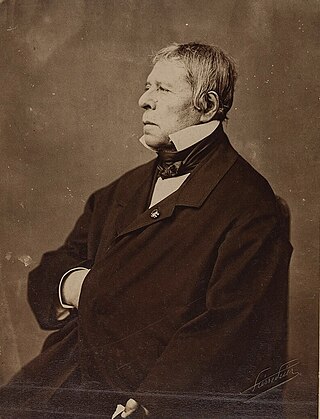
Jean-Auguste-Dominique Ingres was a French Neoclassical painter. Ingres was profoundly influenced by past artistic traditions and aspired to become the guardian of academic orthodoxy against the ascendant Romantic style. Although he considered himself a painter of history in the tradition of Nicolas Poussin and Jacques-Louis David, it is his portraits, both painted and drawn, that are recognized as his greatest legacy. His expressive distortions of form and space made him an important precursor of modern art, influencing Picasso, Matisse and other modernists.
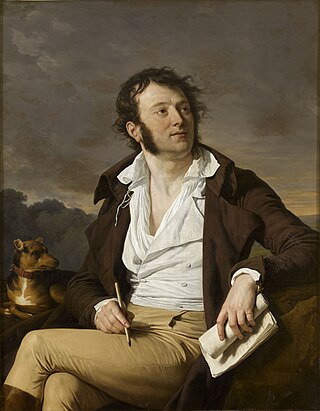
Antoine-Vincent Arnault was a French playwright.

Anne-Louis Girodet de Roussy-Trioson, also known as Anne-Louis Girodet-Trioson or simply Girodet, was a French painter and pupil of Jacques-Louis David, who participated in the early Romantic movement by including elements of eroticism in his paintings. Girodet is remembered for his precise and clear style and for his paintings of members of the Napoleonic family.
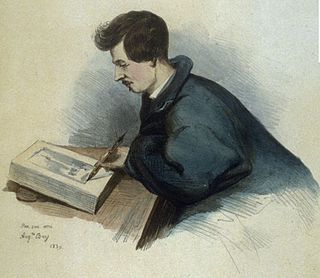
Denis Auguste Marie Raffet was a French illustrator and lithographer. He was a student of Nicolas Toussaint Charlet, and was a retrospective painter of the Empire.

In painting, a pentimento is "the presence or emergence of earlier images, forms, or strokes that have been changed and painted over". Sometimes the English form "pentiment" is used, especially in older sources.

Joseph Méry was a French writer, journalist, novelist, poet, playwright and librettist.
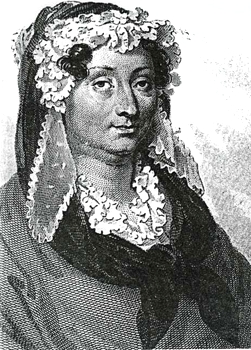
Adélaïde-Gillette Dufrénoy (1765–1825) was a French poet and painter from Brittany.

Louis Abel Beffroy de Reigny was a French dramatist and man of letters.
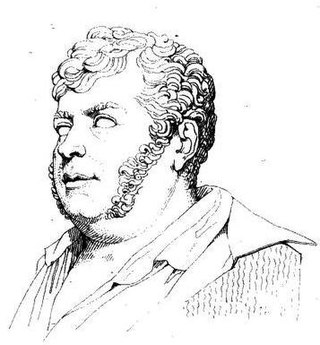
François Guillaume Ducray-Duminil was a French novelist, poet and songwriter.

Antoine Jay was a French writer, journalist, historian and politician.

Jacques-Maximilien Benjamin Bins, comte de Saint-Victor (1772–1858) was a French poet and man of letters.
Jacques Garnier, also called Garnier de Saintes, was born in Saintes on 30 March 1755, and drowned in the Ohio River in 1817 or 1818 was a French politician, a lawyer and a revolutionary.
Emmanuel François Varez called E. F. Varez was an early 19th-century French playwright and novelist.

Portrait of Madame de Senonnes is an 1816 painting by Jean-Auguste-Dominique Ingres. It shows Madame de Senonnes, née Marie-Genevieve-Marguerite Marcoz, viscountess of Senonnes (1783–1828). Marcoz was 31 when the portrait was completed. Ingres had earlier portrayed her in a drawing of 1813.
Augustin-Louis, marquis de Ximénès was an 18th-century French poet and playwright.
Joseph Aurèle Charles de Bossi was a French politician and poet.
Jean-Auguste Jullien, called Desboulmiers, 1731, Paris – 1771, Paris, was an 18th-century French man of letters, historian of theatre and playwright.

Neoclassicism is a movement in architecture, design and the arts which emerged in France in the 1740s and became dominant in France between about 1760 to 1830. It emerged as a reaction to the frivolity and excessive ornament of the baroque and rococo styles. In architecture it featured sobriety, straight lines, and forms, such as the pediment and colonnade, based on Ancient Greek and Roman models. In painting it featured heroism and sacrifice in the time of the ancient Romans and Greeks. It began late in the reign of Louis XV, became dominant under Louis XVI, and continued through the French Revolution, the French Directory, and the reign of Napoleon Bonaparte, and the Bourbon Restoration until 1830, when it was gradually replaced as the dominant style by romanticism and eclecticism.
The French Restoration style was predominantly Neoclassicism, though it also showed the beginnings of Romanticism in music and literature. The term describes the arts, architecture, and decorative arts of the Bourbon Restoration period (1814–1830), during the reign of Louis XVIII and Charles X from the fall of Napoleon to the July Revolution of 1830 and the beginning of the reign of Louis-Philippe.

Amédée, marquis de Pastoret was a French writer and politician.














